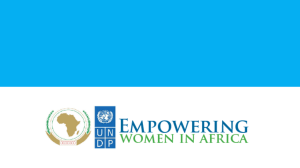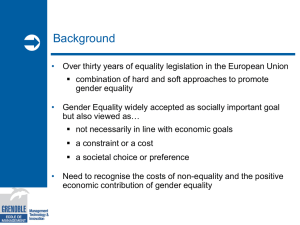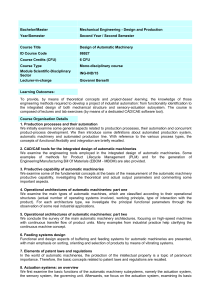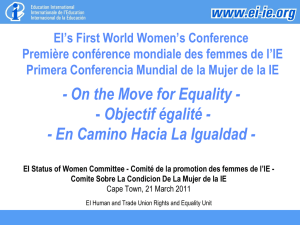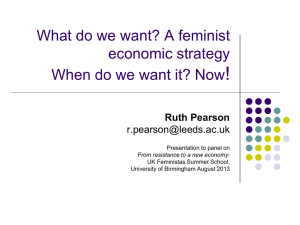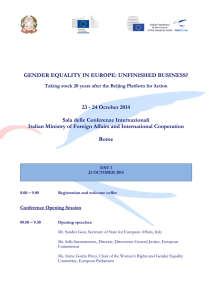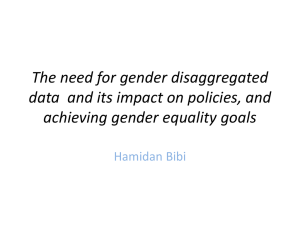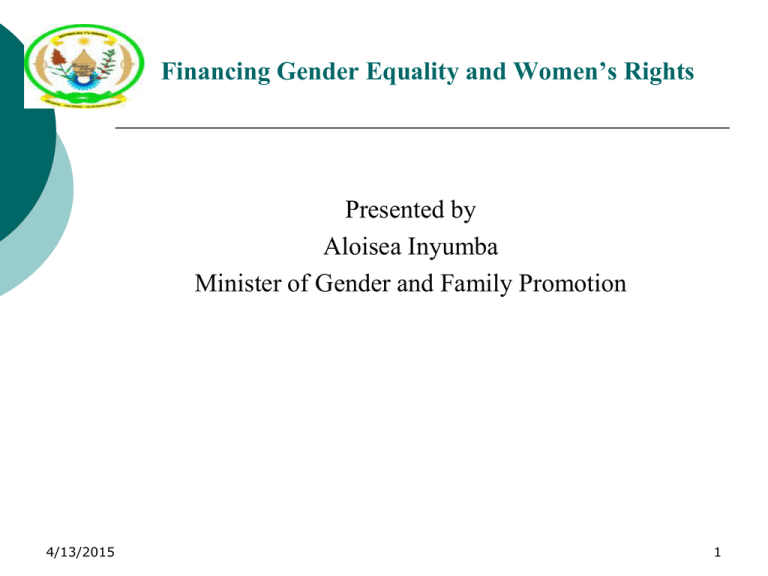
Financing Gender Equality and Women’s Rights
Presented by
Aloisea Inyumba
Minister of Gender and Family Promotion
4/13/2015
1
Outline
Introduction
Financing Gender Equality priorities
Role of Gender Machineries in mainstreaming
gender in planning and budgeting processes
Collaboration between Gender Machineries and
MINECOFIN, sector ministries and women
organizations
Supporting Gender Machineries to advance
financing for Gender Equality goals
Challenges
Way forward
Conclusion
4/13/2015
2
Introduction: Gender Equality priorities
Gender equality is regarded as a development issue
Ensure participation of all people (men and women, girls
and boys) in governance and in pursuing the entire
development agenda. The priorities are enshrined in
various policy, legal and institutional frameworks;
The 2003 Constitution as amended to date (Affirmative
Action)
EDPRS and Vision 2020, MDGs instruments (Gender is a
cross cutting issue)
The major priority for gender equality in Rwanda is
mainstreaming gender in all development pillars:
Governance, Economic development, Social welfare and
Justice;
4/13/2015
3
Gender Machineries/Mechanisms
4/13/2015
Ministry of Gender under the Prime Minister’s office
Gender Monitoring Office
National Women Councils
Gender focal points in all ministries (directors of planning,
per Prime Minister’s instructions)
Gender officers in each district throughout Rwanda
Gender standing committee in Parliament
Political and governance standing committee in Senate
Gender Responsive Budgeting Project in MINECOFIN,
Gender Desks in National Police and Rwanda Defense
Forces
Gender clubs in all high institutions of learning, etc.
4
How Gender Equality priorities are
financed
Financing GE priorities is made through 4 main
channels:
Budget re- prioritization (The budget is not
increased but rather redistributed to suit
programs that are Gender sensitive);
Pro poor and gender sensitive programs, special
programs based on affirmative action principle
are funded as stand alone interventions; One
Cow per poor family, Mutuelles de sante, Bye
Bye Nyakatsi, Ubudehe, VUP, Agaseke, AntiMalaria, etc.
4/13/2015
5
Financing cont’d
Targeted and specific Gender Equality programs:
budget is earmarked to target for instance,
affirmative actions that enhance gender equality
like girls education, encouraging girls to go for
Science and Technology subjects/courses;
Off-budget
financing:
From
development
partners, Civil Society Organizations, charity
organizations to support Gender Equality , joint
programming efforts
4/13/2015
6
Financing priorities cont’d
However, even though these channels
are in place, the actual financing may not
be sufficient for the machineries to
actually carry out the huge mandate.
Gender Responsive Budgeting ought to
target the capacities of the machineries
themselves.
4/13/2015
7
Role of Gender machineries in mainstreaming gender
in planning and budgeting processes
Gender machinery plays critical role in:
Coordination
of the gender equality promotion
agenda;
Policy
advocacy, resource mobilization and
influencing for gender equality;
Capacity
building and empowerment for gender
equality
Provide
inputs in national gender equality tools,
e.g. the budget call circular, the Gender Budget
Statements;
4/13/2015
8
Collaboration between Gender machinery and
MINECOFIN and women organizations
Gender cluster
Joint sector review
Reviewing their action plans
Technical core team
Sector working groups
Public expenditure tracking by Civil
Society Organizations
4/13/2015
9
Challenges
4/13/2015
Weak synergy and coordination
between gender machineries.
Poor gender analysis and planning
Limited availability of sex
disaggregated data
Poor attitude towards gender
responsive budgeting
Need to focus on economic
development
10
Supporting gender machinery to advance financing for
Gender Equality goals
4/13/2015
Capacity building
Develop a common gender
communication strategy
Establish clear gender databanks
11
The Way Forward
4/13/2015
Allocate more resources to build the
capacity of gender machineries
Grow more expertise on gender
analysis
Strengthen communication and
advocacy about gender issues
Increased dialogue on funding
12
Conclusion
4/13/2015
Harnessing the positive political will
and strengthening the institutions is
the key to creating more effective
development.
13
Thank you for your attention
4/13/2015
14


